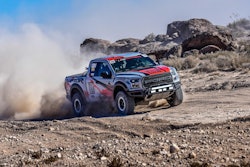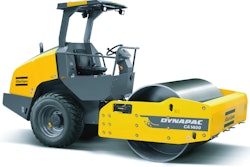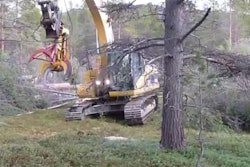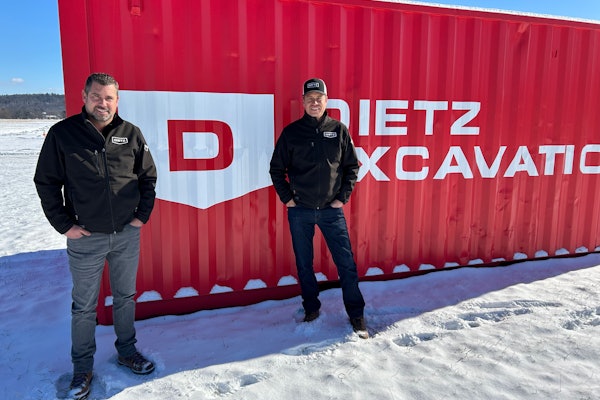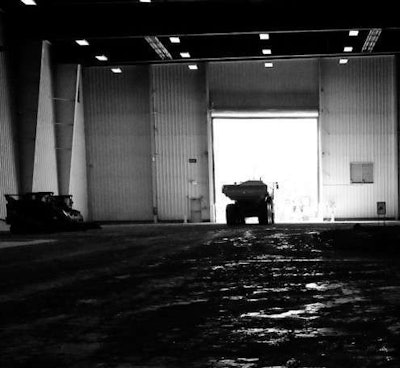
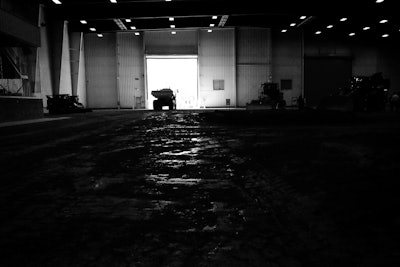 Caterpillar’s Peoria Proving Ground features a larger version of the indoor demonstration arena found at its Edwards facility, pictured here. Photo credit: Wayne Grayson
Caterpillar’s Peoria Proving Ground features a larger version of the indoor demonstration arena found at its Edwards facility, pictured here. Photo credit: Wayne GraysonEven if you could take a photo of Caterpillar’s Peoria Proving Grounds property—which, by the way, you can’t since photography is prohibited at the company’s highly secretive primary testing facility—there wouldn’t be much to look at.
Upon arriving to the facility where steel toed boots, hard hats, protective eyewear and a piece of tape over that smartphone lens are required of visitors, you mainly see mounds of dirt and a few nondescript white metal buildings. Unlike the company’s nearby corporate headquarters or its Edwards Demonstration and Learning Center which are unmistakably marked with the company’s logo, outside the PPG offices you have to find a piece of equipment to see that iconic CAT insignia.
However, the facility’s bland facade in no way reflects what goes on in and around it. As Cat’s Dave Damerell put it Thursday as the company opened the facility to a group of journalists for the first time, PPG is “where and how we develop products.”
Indeed, inside those blank white walls engineers cobble together proof of concept machines, subject machines further through the development process to brutal application simulations and collect data on machine performance in the weeks before and years after launch.
Beyond a tour of the facility, Cat gave Equipment World a peek at two machines in development and detailed the process of bringing a piece of equipment from the drawing board to the dealer.
Paint’s worn off
The crown jewel of the 2,600-acre proving ground property is the Machine Development Center. The MDC is a 150,000 square-foot indoor testing arena housing 3.4 acres of dirt beneath a 41-foot roof. All of that space above and around the machines allows Cat to fully simulate load and dump cycles. And below their tracks is up to 50 feet of dirt for excavation simulations.
When we arrived to the MDC, two prototype machines sat in front of a mound of dirt roughly 20 feet high and 50 yards long. Upon descending the roughly 20 steps from the observation deck down into the arena itself, we found the MH3295 material handler and 637K tractor scraper.
The machines were covered in wires, dents and scrapes—far from the spit-shined units the press is shown at most of these events.
“This machine…has been run through the races. It’s had a lot of things done to it,” said Peter Rummel, the machine validation engineer for scrapers, as he stood in front of the 637K. “It’s about two and a half years old, so it’s a machine that’s had the paint worn off of it. It’s been taken apart and put back together.”
Giving just about any part of the 637K a quick glance betrayed it’s pre-production status as sensors and Ethernet cable crawled all over its extremities. Its presence helped Rummel tell the story of the machine’s development, giving us a rare peek behind Cat’s yellow iron curtain and a glimpse at the way the company’s machines are born.
How to bring a machine to life
Rummel says discussions surrounding the 637K began in 2010 as the company began to envision a Tier 4 Final version of the machine. The process begins with customer interviews, asking owners what they like, what could get better and what should be added to the new model. Cat also asks if there are features or technology that customers would like to see brought over to a new model from different machine types.
That same year a proof of concept was built with help of the company’s Advanced Research Department. Rummel described that early “cobbled together” machine as a bit “rickety,” and, like the late-stage development model on display Thursday, covered in wires.
With that machine, Rummel explained, “We want to prove that the technology is going to work. We want to get operators on it, see if they like it and then also find out if it’s going to improve productivity and efficiency for the operator.”
After the proof of concept has undergone a few validation tests, the machine is then brought to what Cat calls the “pilot platform.”
It’s at this stage that the implementation of a new machine model’s improvements, new features and new technology begins. For instance, early on in the 637K’s development, engineers knew they wanted to carry over some legacy features of the G-Series machine while improving on others such as the cushion hitch, a decades-old feature which improves the ride of the machine for the operator while lessening wear on the structure.
At this point all of the new technology and features are handed off to design engineers who come up with an actual pre-production schematic to be produced by the factory. Mid-2013, three 637K pilot machines were produced and were sent back to the MDC.
Since the 637K features several improvements over the G-Series machine, when those pilot machines arrived at the MDC Rummel had a long list of safety, performance, efficiency and other tests that took the better part of two years to complete.
Those tests start with the engine. “You’ve always gotta start with where your power is coming from,” Rummel says. Next are tests to see if the machine’s cooling package is sized correctly. And thanks to the MDC’s ability to simulate various climates, Cat doesn’t have to ship a machine to the Arizona desert to ensure it has been tested to what Rummel calls “the 95th harshest percentile.”
“Not only is it a covered arena but it’s also a heated arena,” he says. “So we can heat this building to 95 degrees on the floor and run a cooling test in the middle of the winter.”
On-machine stress analysis tests come next, which involve taking everything apart—in the case of the 637K that included the spindles, the frame, the bowl, the pins and more—in order to place sensors called strain gauges on various locations of the machine. On the 637K more than 300 of these sensors were used to monitor and pump streams of data back to the engineers as the machine was tested in real-world situations.
“I go out into the field and I try and run everything that I know the customer is doing with the machine,” Rummel says. “So we’ve done years and years and decades of study on how our customers use the machines. We know that they’re going to go through so many potholes or ditches a day. We know that they’re going to do so many panic stops. We know that they’re going to hook up two machines and they’re going to be push-pulling all day long.
…This machine has got 1,100 hours on it which is early in the life of a scraper. But I’ve put it through a lot.”
The data collected from these OMSA tests is then handed off for analysis to determine whether a machine will meet customer expectations and survive its promised lifespan or whether it’s time to go back to the drawing board. This is no small task in the case of a scraper, as Rummel says most customers expect that machine to last 60 years.
Keep talking
Being that one of Cat’s major focuses moving forward is its ambition to build a network from all of its machines working around the globe in order to reduce downtime through telematics-induced preventative maintenance, the software side of a new machine is another major portion of its development.
And beyond making sure the machines can talk to their owners and operators, at the core of this testing is software architcture validation—making sure the machine can talk to itself. “We have computers all over this machine,” Rummel said of the 637K. “The aftertreatment system has one, the transmission has one, we have one to run all of our hydraulic systems. A great control system has its own computer; all of this has to talk to each other and they have to talk to each other well and they can’t stop talking to each other at any point in time.”
Rummel says software updates are flashed to machines in development periodically throughout the year on all of the different computers on the machine. In many cases those updates are informed from early customer feedback.
A showdown and a field trial
Convinced that the new model meets the expectations of both engineers and customers, the next stage of testing involves pitting the pre-production machine up against its predecessor. For the 637K, Cat’s excellent in-house operators ran it in various applications head-to-head with the 637G.
“In this one the K Series blew the G Series out of the water,” Rummel said.
With the head-to-head tests done the engineers now have a set of production figures the new machine is capable of and a strong reading on how solid of an update all the changes have amounted to. At this point a couple of the machines are handed off to customers for testing on actual jobsites.
Cat encourages these customers to use the machine as they normally would and incorporate any feedback they supply into manufacturing the production model. Cat also mounts a black box called a Super Comm 2 to the top of these field test machines that ties into the electrical architecture of the machine.
“Every channel that’s being measured just to run the machine—system pressures, currents, voltages fan speeds, engine speeds, accelerations—all of that information goes to that box,” Rummel says.
The box contains a cellular modem which transmits data back to Cat where it can be accessed by engineers, allowing them to monitor the machine’s performance throughout the field trials.
Once those customer trials are complete, the model enters NPI or the New Product Introduction phase.
At this point the engineers head to the factory and oversee the assembly of several units a few months before they hit the full assembly line. “What that does is it validates all that goes on in the factory. Can they build this machine to the same qualifications that we want?” Rummel explains. “And then we take those machines and send them out to customers as well. And they continue to run through production and we’ll monitor them to see if there’s any issues.”
Production
Once production of the machine has begun, doesn’t mean the life of those old pilot machines is over.
“This machine continues to stay here at the proving grounds and any issues [the customers] come up with I go out in this machine and see if I can replicate the issue. …And any fixes we have we validate them and send them along to the customer,” Rummel says.
The 637K is a machine six years in the making. And though production will begin in the next few weeks, Rummel says his pilot unit will remain his home away from home.




